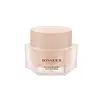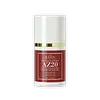What's inside
What's inside
 Key Ingredients
Key Ingredients

 Benefits
Benefits

 Concerns
Concerns

 Ingredients Side-by-side
Ingredients Side-by-side

Tuber Melanosporum Extract
HumectantGlycerin
HumectantWater
Skin ConditioningCaprylic/Capric Triglyceride
MaskingPropanediol
SolventCetearyl Alcohol
EmollientMacadamia Ternifolia Seed Oil
EmollientMangifera Indica Seed Butter
Skin ConditioningGlycereth-26
HumectantDiheptyl Succinate
EmollientCetearyl Olivate
Glyceryl Stearate
EmollientGlyceryl Glucoside
HumectantSqualane
EmollientElaeis Guineensis Oil
EmollientSh-Oligopeptide-1
Skin ConditioningHydrogenated Rapeseed Oil
EmollientPanthenol
Skin ConditioningSorbitan Olivate
EmulsifyingCapryloyl Glycerin/Sebacic Acid Copolymer
Skin Conditioning1,2-Hexanediol
Skin ConditioningCaprylyl Glycol
EmollientOlivoyl Hydrolyzed Wheat Protein
CleansingCarbomer
Emulsion StabilisingAmmonium Acryloyldimethyltaurate/Vp Copolymer
Arginine
MaskingGlycosyl Trehalose
Emulsion StabilisingGlyceryl Oleate
EmollientDipropylene Glycol
HumectantHydrogenated Starch Hydrolysate
HumectantBoswellia Carterii Oil
MaskingTocopherol
AntioxidantAllantoin
Skin ConditioningBakuchiol
AntimicrobialDipotassium Glycyrrhizate
HumectantGlyceryl Caprylate
EmollientAdenosine
Skin ConditioningCeramide NP
Skin ConditioningEthylhexylglycerin
Skin ConditioningCaprylhydroxamic Acid
Glucose
HumectantSodium Hyaluronate
HumectantLysolecithin
EmulsifyingPhytosphingosine
Skin ConditioningAcetyl Hexapeptide-8
HumectantOligopeptide-29
AntioxidantTuber Melanosporum Extract, Glycerin, Water, Caprylic/Capric Triglyceride, Propanediol, Cetearyl Alcohol, Macadamia Ternifolia Seed Oil, Mangifera Indica Seed Butter, Glycereth-26, Diheptyl Succinate, Cetearyl Olivate, Glyceryl Stearate, Glyceryl Glucoside, Squalane, Elaeis Guineensis Oil, Sh-Oligopeptide-1, Hydrogenated Rapeseed Oil, Panthenol, Sorbitan Olivate, Capryloyl Glycerin/Sebacic Acid Copolymer, 1,2-Hexanediol, Caprylyl Glycol, Olivoyl Hydrolyzed Wheat Protein, Carbomer, Ammonium Acryloyldimethyltaurate/Vp Copolymer, Arginine, Glycosyl Trehalose, Glyceryl Oleate, Dipropylene Glycol, Hydrogenated Starch Hydrolysate, Boswellia Carterii Oil, Tocopherol, Allantoin, Bakuchiol, Dipotassium Glycyrrhizate, Glyceryl Caprylate, Adenosine, Ceramide NP, Ethylhexylglycerin, Caprylhydroxamic Acid, Glucose, Sodium Hyaluronate, Lysolecithin, Phytosphingosine, Acetyl Hexapeptide-8, Oligopeptide-29
Water
Skin ConditioningAzelaic Acid
BufferingPropylene Glycol
HumectantSodium Hydroxide
BufferingCaprylic/Capric Triglyceride
Masking1,2-Hexanediol
Skin ConditioningCetearyl Alcohol
EmollientGlyceryl Stearate
EmollientDimethicone
EmollientCetearyl Olivate
Sorbitan Olivate
EmulsifyingBetaine
HumectantDimethyl Sulfone
SolventPanthenol
Skin ConditioningAllantoin
Skin ConditioningDipotassium Glycyrrhizate
HumectantCentella Asiatica Extract
CleansingMadecassoside
AntioxidantSodium Hyaluronate
HumectantHydrolyzed Hyaluronic Acid
HumectantTocopherol
AntioxidantCeramide NP
Skin ConditioningPolysorbate 60
EmulsifyingCamellia Sinensis Leaf Extract
AntimicrobialSambucus Nigra Flower Extract
RefreshingMomordica Charantia Fruit Extract
Skin ConditioningLeontopodium Alpinum Extract
Skin ConditioningWater, Azelaic Acid, Propylene Glycol, Sodium Hydroxide, Caprylic/Capric Triglyceride, 1,2-Hexanediol, Cetearyl Alcohol, Glyceryl Stearate, Dimethicone, Cetearyl Olivate, Sorbitan Olivate, Betaine, Dimethyl Sulfone, Panthenol, Allantoin, Dipotassium Glycyrrhizate, Centella Asiatica Extract, Madecassoside, Sodium Hyaluronate, Hydrolyzed Hyaluronic Acid, Tocopherol, Ceramide NP, Polysorbate 60, Camellia Sinensis Leaf Extract, Sambucus Nigra Flower Extract, Momordica Charantia Fruit Extract, Leontopodium Alpinum Extract
 Reviews
Reviews

Ingredients Explained
These ingredients are found in both products.
Ingredients higher up in an ingredient list are typically present in a larger amount.
1,2-Hexanediol is a synthetic liquid and another multi-functional powerhouse.
It is a:
- Humectant, drawing moisture into the skin
- Emollient, helping to soften skin
- Solvent, dispersing and stabilizing formulas
- Preservative booster, enhancing the antimicrobial activity of other preservatives
Allantoin is a soothing ingredient known for its protective and moisturizingg properties. Because of this, it is often added to products with strong active ingredients.
Studies show higher concentrations of this ingredient can promote wound healing.
Though it can be derived from the comfrey plant, allantoin is produced synthetically for cosmetic products to ensure purity.
Learn more about AllantoinThis ingredient is an emollient, solvent, and texture enhancer. It is considered a skin-softener by helping the skin prevent moisture loss.
It helps thicken a product's formula and makes it easier to spread by dissolving clumping compounds.
Caprylic Triglyceride is made by combining glycerin with coconut oil, forming a clear liquid.
While there is an assumption Caprylic Triglyceride can clog pores due to it being derived from coconut oil, there is no research supporting this.
Learn more about Caprylic/Capric TriglycerideCeramide NP is a type of ceramide and formally known as ceramide 3.
Ceramides are intercellular lipids naturally found in our skin that bonds dead skin cells together to create a barrier. They are known for their ability to hold water and thus are a great ingredient for dry skin.
Ceramides are an important building block for our skin barrier. A stronger barrier helps the skin look more firm and hydrated. By bolstering the skin ceramides act as a barrier against irritating ingredients. This can help with inflammation as well.
If you would like to eat ceramides, sweet potatoes contain a small amount.
Read more about other common types of ceramides here:
Ceramide AP
Ceramide EOP
Cetearyl alcohol is a mixture of two fatty alcohols: cetyl alcohol and stearyl alcohol. It is mainly used as an emulsifier. Emulsifiers help prevent the separation of oils and products. Due to its composition, it can also be used to thicken a product or help create foam.
Cetearyl alcohol is an emollient. Emollients help soothe and hydrate the skin by trapping moisture.
Studies show Cetearyl alcohol is non-toxic and non-irritating. The FDA allows products labeled "alcohol-free" to have fatty alcohols.
This ingredient is usually derived from plant oils such as palm, vegetable, or coconut oils. There is debate on whether this ingredient will cause acne.
Due to the fatty acid base, this ingredient may not be Malassezia folliculitis safe.
Learn more about Cetearyl AlcoholCetearyl Olivate is an emulsifier and texture enhancer. It is derived from the fatty acids of olive oil and Cetearyl alcohol, and is biodegradable.
As an emulsifier, it is used to prevent oils and waters from separating. It can also
Manufacturers use the name Olivem 1000. This ingredient has been found to preserve the natural microbiome of skin. Having a healthy microbiome helps keep our skin healthy and protects against harmful bacteria. This ingredient is grouped with Sorbitan Olivate under the name Olivem 1000.
Learn more about Cetearyl OlivateDipotassium Glycyrrhizate comes from licorice root.
Extracts of licorice have demonstrated to have antibacterial, anti‐inflammatory, antiviral, antioxidant properties.
One component, glabridin, has extra potent antioxidant and soothing properties. It has also been found to block pigmentation from UVB rays in guinea pigs.
Licorice Root also contains a flavonoid. Flavonoids are a natural substance from in plants. Flavonoids also have antioxidant properties.
Another component, glycyrrhizin, has been found to have anti-inflammatory and antimicrobial benefits. This may make licorice root extract effective at treating acne. However, more research is needed to support this.
Liquiritin is one of the flavone compounds found in licorice. It has been found to help lighten skin by preventing tyrosinase from reacting with tyrosine. When the two react, protein is converted to melanin. Melanin is the substance in your body that gives your features pigmentation.
Licorice root is native to Southern Europe and Asia. It has been used in traditional Chinese medicine to help with respiratory issues.
Learn more about Dipotassium GlycyrrhizateGlyceryl Stearate is a mix of glycerin and stearic acid.
It is used to stabilize the mixing of water and oil ingredients. By preventing these ingredients from separating, it can help elongate shelf life. It can also help thicken the product's texture.
As an emollient, it helps soften skin and supports barrier-replenishing ingredients.
In cosmetics, Glyceryl Stearate is often made from vegetable oils or synthetically produced.
This ingredient may not be fungal-acne safe
Fun fact: The human body also creates Glyceryl Stearate naturally.
Learn more about Glyceryl StearatePanthenol is a common ingredient that helps hydrate and soothe the skin. It is found naturally in our skin and hair.
There are two forms of panthenol: D and L.
D-panthenol is also known as dexpanthenol. Most cosmetics use dexpanthenol or a mixture of D and L-panthenol.
Panthenol is famous due to its ability to go deeper into the skin's layers. Using this ingredient has numerous pros (and no cons):
Like hyaluronic acid, panthenol is a humectant. Humectants are able to bind and hold large amounts of water to keep skin hydrated.
This ingredient works well for wound healing. It works by increasing tissue in the wound and helps close open wounds.
Once oxidized, panthenol converts to pantothenic acid. Panthothenic acid is found in all living cells.
This ingredient is also referred to as pro-vitamin B5.
Learn more about PanthenolSodium Hyaluronate is hyaluronic acid's salt form. It is commonly derived from the sodium salt of hyaluronic acid.
Like hyaluronic acid, it is great at holding water and acts as a humectant. This makes it a great skin hydrating ingredient.
Sodium Hyaluronate is naturally occurring in our bodies and is mostly found in eye fluid and joints.
These are some other common types of Hyaluronic Acid:
Learn more about Sodium HyaluronateSorbitan Olivate is created from the fatty acids in olive oil and sorbitol.
This ingredient is an oil in water emulsifier. It helps stabilize a product by preventing oils and waters from separating. Sorbitan Olivate also helps hydrate the skin.
Manufacturers sell sorbitan olivate under the name OliveM 1000. OliveM 1000 a multifunctional ingredient. It is self-emulsifying. According to a manufacturer, OliveM 1000 does not disrupt natural skin biome.
Due to its olive oil base, this ingredient may not be fungal-acne safe.
Learn more about Sorbitan OlivateTocopherol (also known as Vitamin E) is a common antioxidant used to help protect the skin from free-radicals and strengthen the skin barrier. It's also fat soluble - this means our skin is great at absorbing it.
Vitamin E also helps keep your natural skin lipids healthy. Your lipid skin barrier naturally consists of lipids, ceramides, and fatty acids. Vitamin E offers extra protection for your skin’s lipid barrier, keeping your skin healthy and nourished.
Another benefit is a bit of UV protection. Vitamin E helps reduce the damage caused by UVB rays. (It should not replace your sunscreen). Combining it with Vitamin C can decrease sunburned cells and hyperpigmentation after UV exposure.
You might have noticed Vitamin E + C often paired together. This is because it is great at stabilizing Vitamin C. Using the two together helps increase the effectiveness of both ingredients.
There are often claims that Vitamin E can reduce/prevent scarring, but these claims haven't been confirmed by scientific research.
Learn more about TocopherolWater. It's the most common cosmetic ingredient of all. You'll usually see it at the top of ingredient lists, meaning that it makes up the largest part of the product.
So why is it so popular? Water most often acts as a solvent - this means that it helps dissolve other ingredients into the formulation.
You'll also recognize water as that liquid we all need to stay alive. If you see this, drink a glass of water. Stay hydrated!
Learn more about Water